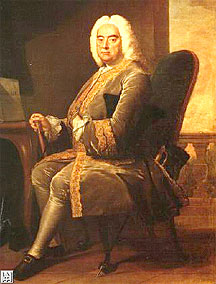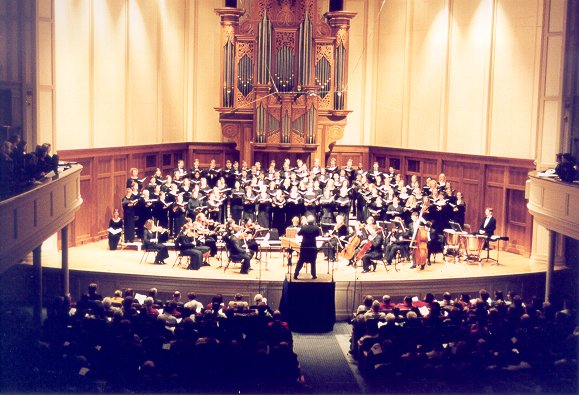Later, I thought, I'd like to know more about the Messiah.
[Note from the Apple Lady, 12/2007: I just saw a performance of the Messiah in its entirety, so I have some more information to impart. The updated stuff is inserted throughout.]

Handel, in his later years. Eventually, in addition to being paralyzed from a stroke, he would be blinded by cataracts.
(Image sourced from Le Roi s'amuse's page on G.F. Handel)
- It's an oratorio, one of several that George Frideric Handel wrote toward the end of his life. Oratorios are often written based on Biblical texts. They are similar to operas, but they are performed in concert, without staging or scenery or costumes. Thus oratorios are cheaper to perform.
- The Messiah was first performed in 1742 in Dublin.
- It was originally conceived and performed for Easter.
- Handel wrote the work in the fall of 1742. At the time, he was paralyzed on his left side from a stroke suffered four years previously. Even so, he completed the oratorio in only 24 days.
- If you think of the English word that's similar to oratorio, oration, you have kind of an idea of what the whole program is like. Sometimes a soloist gets up and sings for a while, then that person sits down, another soloist gets up and sings for a while, that person sits down, and the whole chorus sings for a while. It's kind of like everybody's giving mini-orations, but in song form. And what they're telling you is lines from various books of the Bible.

Probably what you'd see if you went to see a performance of the Messiah yourself. In this photo, the choir is standing, which means it's their turn to sing. The woman sitting off to the left by herself is probably a soloist waiting for her turn.
(Photo of Robert Levy conducting the Messiah at Lawrence University)
- The text does tell a story, though it gets a little fluid in the middle. First is the foretelling of Jesus' birth, then the announcement of his birth to the shepherds, his suffering and death, his resurrection and the subsequent salvation and resurrection of everybody else. Since the story doesn't stop with the birth of Jesus but goes on to his death and resurrection, it is more appropriate for Easter rather than Christmas. But it has become traditional to perform the Messiah at Christmas.
- The text for the Messiah was chosen by a man named Charles Jennens, who was a literary scholar and editor of Shakespeare's plays and a personal acquaintance of Handel's.
- The most famous portion of the Messiah is the Hallelujah chorus, which takes as its text three passages from the New Testament book of Revelation.
- The Hallelujah chorus, which is one small portion that the chorus sings and which begins with the word Hallelujah!, isn't even the grand finale. It comes about 3/4 the way through the program.

What the opening of the Hallelujah chorus looks like, on a modern and score for a choral director's use.
(Image from the East London Chorus)
- The work has endured countless revisions and additions of instruments and vocalists. One of the first major revisions of Messiah was undertaken in 1788 by Wolfgang Amadeus Mozart, thirty years after Handel's death.
- The story has been handed down that on first hearing the chorus, King George II rose to his feet, which required everyone attending the concert to rise as well. Speculations abound as to the reasons why he stood up -- he arrived late, he wanted to stretch his legs, he had to go to the bathroom, etc. Nobody can say for sure if the story about the kind standing up is true, and if he did stand, why he did so. Nonetheless, standing during the Hallelujah chorus continues to be customary.
- And I have to say, having just seen it performed, it is truly magnificent. If any piece of music deserves to have the audience stand en masse out of respect for it, it might as well be that one.
To see what the original score looks like at another part of the Hallelujah chorus, go to this image owned by the British Library.
To hear the Hallelujah chorus, go to the "ShareAlike" downloadable files: http://hebb.mit.edu/FreeMusic/Handel/ (scroll all the way down)
Sources:
Encarta, George Frideric Handel
Wikipedia, George Frideric Handel and Messiah (Handel)
G.F. Handel.org, Messiah: "A Sacred Oratorio"
Hartford Chorale, Handel's Messiah
Tom Lumb, Survey of Musical Directors' views on audiences standing during the Hallelujah chorus, Festival Singers of Wellington, January 1998
No comments:
Post a Comment
If you're a spammer, there's no point posting a comment. It will automatically get filtered out or deleted. Comments from real people, however, are always very welcome!